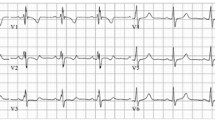Abstract
Atrial septal defects (ASDs) vary greatly depending on their size, age at closure, and clinical management. This report characterizes the prevalence, complexity, and clinical management of these lesions in a statewide pediatric cohort and examines predictors for receiving closures. A 15-year Medicaid data set (1996–2010) from one state was analyzed. The selection criteria specified patients 17 years of age or younger with a diagnosis of ASD primum, secundum, or sinus venosus on one or more service visits to a pediatrician or pediatric cardiologist. During the 15-year period, ASDs represented a prevalence rate for treatment of 0.47/1000 CHDs identified, with 61 % presenting as complex lesions. Concomitant cardiac anomalies that might have a negative impact on prognosis were present including patent ductus arteriosus (26.1 %), pulmonary hypertension (3.8 %), and supraventricular tachycardia (2.4 %). Pharmacologic treatments, predominantly diuretics, were prescribed for 21 % of the cohort. Both surgical closures (6.3 %) and transcatheter closures (1.4 %) were used for ASD secundum cases, whereas surgical closures predominated for ASD primum (25.6 %) and sinus venosus (13.5 %) lesions. The postoperative follow-up period was two to three times longer for children with ASD primum or sinus venosus than for those with ASD secundum (average, ~1 year). Factors predicting the likelihood of having ASD closure were older age, having a concomitant patent ductus arteriosus (PDA) repair, treatment with ibuprofen, having two or more concomitant CHDs, and receiving diuretics or preload/afterload-reducing agents. Care of ASDs in routine practice settings involves more complications and appears to be more conservative than portrayed in previous investigations of isolated ASDs.
Similar content being viewed by others
References
Bernstein D (2011) Atrial septal defects. Chap. 420.1. In: Kleigman RM, Stanton B, St. Geme J, et al (eds) Nelson textbook of pediatrics, 19th edn. Saunders. Accessed 23 September 2011 http://www.mdconsult.com/books/page.do?eid=4-u1.0-B978-1-4377-0755-7..00420-6&isbn=978-1-4377-0755-7&sid=1420794237&uniqId=406027988-3#4-u1.0-B978-1-4377-0755-7..00420-6–sc0010
Bernstein D (2011) Ostium secundum defect. Chap. 420.2. In: Kleigman RM, Stanton B, St. Geme J, et al (eds) Nelson textbook of pediatrics. 19th edn. Saunders. Accessed 23 September 2011 at http://www.mdconsult.com/books/page.do?eid=4-u1.0-B978-1-4377-0755-7..00420-6–s0010&isbn=978-1-4377-0755-7&uniqId=406027988-9
Botto LD, Correa A, Erickson JD (2001) Racial and temporal variations in the prevalence of heart defects. Pediatrics 107:E32
Census 2010: summary file 2, demographic profile 1 by state. Accessed 4 February 2013 at http://factfinder2.census.gov/faces/tableservices/jsf/pages/productview.xhtml?pid=DEC_10_SF2_SF2DP1&prodType=table
Goetschmann S, Dibernardo S, Steinmann H, Pavlovic M, Sekarski N, Pfammatter JP (2008) Frequency of severe pulmonary hypertension complicating “isolated” atrial septal defect in infancy. Am J Cardiol 102:340–342
Hanslik A, Pospisil U, Salzer-Muhar U, Greber-Platzer S, Male C (2006) Predictors of spontaneous closure of isolated secundum atrial septal defect in children: a longitudinal study. Pediatrics 118:1560–1565
Health insurance coverage for children under 19 years of age, at or below 200% of poverty by state, 2006–2008 and 2009–2011. Accessed 30 January 2013 at http://www.census.gov/hhes/www/hlthins/data/children/low-income.html
Helgason H, Jonsdottir G (1999) Spontaneous closure of atrial septal defects. Pediatr Cardiol 20:195–199
Hoffman JI, Kaplan S (2002) The incidence of congenital heart disease. J Am Coll Cardiol 39:1890–1900
Keane JF, Geva T, Fyler DC (2011) Atrial septal defect. Chap. 34. In: Keane JF (ed) Nadas pediatric cardiology. 2nd edn. Accessed 28 November 2012 at http://www.mdconsult.com/books/page.do?eid=4-u1.0-B978-1-4160-2390-6..50039-8&isbn=978-1-4160-2390-6&sid=1420797003&uniqId=406027988-4#4-u1.0-B978-1-4160-2390-6..50039-8
Kharouf R, Luxenberg DM, Khalid O, Abdulla R (2008) Atrial septal defect: spectrum of care. Pediatr Cardiol 29:271–280
Pradat P, Francannet C, Harris JA, Robert E (2003) The epidemiology of cardiovascular defects: part I. A study based on data from three large registries of congenital malformations. Pediatr Cardiol 4:195–221
Table D1: children under 18 and their designated parents, and Table D2: children under 18 and their designated parents: characteristics of families (including region). Accessed 30 January 2013 at http://www.census.gov/hhes/socdemo/children/data/sipp/well2009/tables.html
Acknowledgments
Funding for this study was provided through a Clinical Incentive Research Grant from the University of South Carolina, Office of the Provost. No external funding was received.
Conflict of interest
The authors have no conflicts of interest to report.
Author information
Authors and Affiliations
Corresponding author
Rights and permissions
About this article
Cite this article
Shuler, C.O., Tripathi, A., Black, G.B. et al. Prevalence of Treatment, Risk Factors, and Management of Atrial Septal Defects in a Pediatric Medicaid Cohort. Pediatr Cardiol 34, 1723–1728 (2013). https://doi.org/10.1007/s00246-013-0705-5
Received:
Accepted:
Published:
Issue Date:
DOI: https://doi.org/10.1007/s00246-013-0705-5




